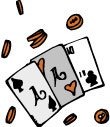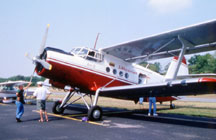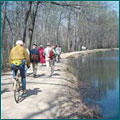82. Find a Book to Shape Your Summer
For everything there is a season, and for every season there is a book. The right book can bend and shape your summer the way a prism bends and shapes sunlight, isolating it in your memory from all other summers.
You might remember the summer you read Watership Down, for example, as a summer full of easy companionship and natural wonder, or the summer you read Papillon as a summer of heat and humidity and lonely desperation, but one when you were keenly aware of your personal freedom.
Finding such a book can be a daunting task. There are literally millions to choose from, and most of those simply aren’t worth reading. So how do you go about finding one that is?
Don’t go to the bookstore unless you know exactly what book you want and can’t find it at the library. Twelve dollars is too much to spend on a book you may abandon after the first three chapters.
Start at the library, instead. Sit down at a terminal and type in a subject that interests you, and let the computer feed you a list of suggestions. Find those books on the shelves, but remember — the secret to finding a good book is browsing. Look at the books that surround those the computer suggested. Be patient and you’re sure to strike gold.
If you sit down at the computer terminal and sit staring at the screen, not sure what subject you’re interested in, try typing in a word related to Chesapeake Country — boats or horses or fireflies or crabs — and see where that takes you. The Bay can be your conduit to the world in the library as easily as in life.
Check out a few books at a time, since some are bound to be duds — but not too many to keep track of: Library fines accumulate quickly.
Good luck, and happy reading.
83. Volunteer at an Animal Shelter
Remember the time your cat caught the baby bunny and brought it into your house? Or when your daughter found the newly hatched bird that had fallen out of its nest? Or when your dog brought home that turtle? Or when the squirrels were damaging your roof? You probably telephoned one of the local wildlife centers. They’re always ready to help us humans in our bumbling interactions with the wildlife in our backyard.
Now’s the time to help them out. They’re open seven days a week and they need volunteers. You’ll feed that orphaned bird, use surgical glue to close the rabbit’s wounds, build shelters and be part of a team working to rehabilitate the animals for release back into the wild.
Don’t have the time? The wildlife centers also need shredded newspapers, stainless steel cages, computer equipment, baby food, hay, mops, and paint brushes. Give them a call to find out what’s on their wish lists:
Chesapeake Wildlife Sanctuary in Bowie: 301-390-7010 • www.chesapeakewildlife.org.
Noah’s Ark Wildlife Center in Annapolis: 410/626-7700.
While you’re at it, don’t forget the needs of domestic animals. They’re sitting in shelters waiting to be adopted. The animal shelters could use volunteers to answer the telephone, walk the dogs, contribute to their newsletters or to sew beds. They also need donations of such things as leashes, dog and cat food, blankets, towels, detergent and light bulbs.
In Anne Arundel, SPCA of Anne Arundel County: 410/268-4388, www.aacspca.org.
In Calvert, you’ve got lots of choices:
84. Play Cards on the Porch
In most households, it’s become routine to shut all the windows and crank up the air conditioning the moment the thermometer reaches 70. Most families spend summer evenings sprawled across couches, paying more attention to the television than to one another.
Nobody remembers nights like that. As kids become teens and teens become adults and adults become senior citizens, what we all remember are those summer nights we spent out on the porch, laughing along with a chorus of crickets to the rhythmic rustle of playing cards.
You can always take your cards to the beach and play a quick game of war (or gin, for adults) while the sun’s rays brush Bay brine from your shoulders. Wet, wrinkled fingers leave indelible imprints on playing cards, but games played after dark leave more of an impression on your mind.
 Most memorable are those games played on the porch over a perspiring beverage, your spine quivering and skin prickling as the sun’s touch burns deeper into your shoulders. You need Ray Charles on the radio and as many decks of cards as you can get your hands on.
Most memorable are those games played on the porch over a perspiring beverage, your spine quivering and skin prickling as the sun’s touch burns deeper into your shoulders. You need Ray Charles on the radio and as many decks of cards as you can get your hands on.
You need some showing the sun sinking beneath the Chesapeake and some showing Annapolis street scenes, some showing sailboats and some showing Blue Angels and some decorated with intricate arabesques (red or blue). That way, everyone can pick a favorite and deal from that deck when their turn comes around.
You must play in the heat and humidity, of course. No air conditioning is allowed, but you may be grateful if your porch is screened in, leaving the mosquitoes knocking at the mesh instead of jabbing at your flesh. You may also be happy if your yard is alight with fireflies or — better yet — the sky streaked with lightning and the air thick with thunder.
The best games to play, under any circumstance, are solitaire (played alone or shoulder-to-shoulder), cribbage (especially good for grampas and granddaughters), hearts (for four players, only), rummy (for any number), pinochle (use two decks) and poker. If you play poker with chips, remember to decide what’s worth what before you start, since some people think the blues are worth the most, some people think it’s the red and some the white. Or you can just use pennies.
Don’t know the rules? That’s what grammas are for (though I suggest you keep a copy of Hoyle’s on hand, for emergencies).
85. NJFK: Taste Bay Water
Is the Bay water fresh or salty? The next time you’re down by the Bay, take a sip. Swill it around and spit it out. How does it taste? Can you smell the saltiness? Can you feel it on your skin after a swim?
The Chesapeake is an estuary, meaning that salt water from the Atlantic Ocean mixes with fresh water from rivers and streams flowing into the Bay, like the Susquehanna River in Pennsylvania and the Patuxent and Potomac rivers in Maryland.
Table salt, sodium chloride, is the most common mineral in salt water.
Put some drops of Bay water in a small bowl and leave it in the sun for a few hours. Are there minerals in the bottom of the bowl after the water evaporates? Do they taste salty?
Bay waters are more salty the closer one gets to the ocean. Try several spots along the Bay from Baltimore to St. Marys City. The water is also saltier down deep than it is on the surface because salt water sinks. Can you tell the difference?
 86. Taxi Down to a Country Airstrip
86. Taxi Down to a Country Airstrip
Here’s one excuse. You may use any other just as well.
It’s a lovely sunny day, not too humid with a slight breeze. Your daughter has a cold, so you don’t want to take her to the pool, but you want to be outdoors, maybe have the kids run around a clean stretch of lawn. So you pack a lunch and head for the airport.
Nowadays big airports are seldom pleasant destinations, especially when you’re scheduled to pick up your in-laws from BWI precisely at rush hour.
The small airstrips sprinkled around Bay Country are a different matter. Once you’ve established that you’re not a threat — it’s prudent to check in with the airport manager — you’d be surprised how close you can get to the turf-lined runway to enjoy the landings and takeoffs of small craft. And if at first you can’t distinguish a Piper from a Cessna from an Ultralight, you might be taken under some pilot’s wing and have it all explained.
Of the three public light-use airports in Anne Arundel County, Lee Airport in Edgewater is renown for its welcoming attitude (and absent your own picnic, you can always order a pizza at Ledo’s and avail yourself of the tables out back that look onto the airstrip). At Bay Bridge Airport, right at the eastern end of the Bridge, you can enjoy the waterview as well as aircraft maneuverings.
Once you’ve mastered the light-use airstrips, try graduating to county or regional airports with their larger runways and larger planes. St. Mary’s County airport is just four miles northeast of Leonardtown, and Easton Airport in Talbot County, with its Hanger Cafe, is right on Route 50. Remember, these days they may be more restrictive to visitors than are the light-use airports.
Finally, learn to fly. Buy your own plane, and fly, don’t drive, to your favorite runway.
87. Take a Ride on the Wild Side
From the back of the Harley-Davidson: Moving while sitting still. Sun on my back. Smell of cut grass, dry fields, farm manure, pine trees, pork-barbecue, asphalt, wind. Clack of the shield against my helmet. No conversation. No radio. Welcome silence inside. Thoughts blowing past in the wind. Peripheral vision of cars, trucks, green trees and roadside weeds whizzing by. Barns, horses, fields, woods. Shadow and sunlight. A lasso of light in the rearview mirror from the motorcycle behind. Highway streaming past on the silver helmet in front. Feel of clothing pushing against legs, arms, chest. Comforting broad back of the driver. Clunk of helmet bouncing against helmet in the slow motion of stop and go. Moving and sitting still. The ache of the sit-bones reminds me this is not a dream.
It’s time to move to the front. The first step is MVA’s motorcycle safety program. For $100, I’m registered for 15 hours of training on and off an MVA supplied motorcycle. I must show up at Annapolis MVA on Thursday, July 11 with an approved helmet, eye protection, gloves, long sleeve shirt, long pants and over-the-ankle leather shoes. Topics covered include risk awareness, acceptance and management; protective gear; pre-ride inspection and motorcycle maintenance. Next come riding skills, safety rules and signals. After that, street strategies teach positioning the motorcycle, becoming visible to other drivers, braking and swerving, as well as common and special riding situations. There’s a test at the end. If I pass (and also pass a vision test), I can pay a fee to get a class M driver’s license. Then I can check out the scene from the front of the Harley.
Courses fill months in advance. I signed up in February for the July course: 800/638-1722 • marylandmva.com/MVAprog/moto.
88. Take to a Trail
 Annapolis, should be the walking capital of the country. Stand on the Poplar Trail downtown and face north, east, south or west. Connecting trails will take you to either the Atlantic or Pacific Coast and, one day, as far as Maine or Key West.
Annapolis, should be the walking capital of the country. Stand on the Poplar Trail downtown and face north, east, south or west. Connecting trails will take you to either the Atlantic or Pacific Coast and, one day, as far as Maine or Key West.
The Poplar Trail in downtown Annapolis, completed in 2000, was the final link between downtown trails that get you out of town. Linking Poplar and Taylor avenues, it connects with the Colonial Annapolis Maritime Trail, which leads to route 450, across the Naval Academy Bridge, to route 50 over the Chesapeake. Now you’re on the American Discovery Trail, which takes you all the way to Cape Henlopen National Seashore in Delaware.
Or get on the B&A Trail and head north to the East Coast Greenways Trail. Upon its completion in 2010, it will take you as far north as Maine and as far south as Key West.
The American Discovery Trail and the East Coast Greenway are both National Millennium Trails, part of a national initiative launched in 2000 to protect green spaces and preserve history by creating a network of trails across America.
If you don’t care to go so far, you can spend a very pleasant afternoon just walking the trails that lead through our fair capital city. Annapolis Department of Transportation on Chinquapin Round Road has maps of the trail system.
The Spa Creek Trail winds from Truxtun Park past Spa Creek Conservancy, the Chesapeake Children’s Museum and Maryland Hall. Take the Eastport Historic Walking Tour across Spa Creek Bridge to the Colonial Annapolis Maritime Trail that winds through the streets of historic Annapolis to the Naval Academy. The Visitor’s Center at the Capital has a brochure listing all the historic stops along the way. Or stroll through the Academy on the U.S. Naval Academy trail.
Get out of that car and take a hike.
89. Savor Summer Specialties: Barbecue Vegetarian
It started with your teenage daughter. She took one look at the three-point buck you bagged last season and screamed she’d never eat meat again. Then your wife went shopping for a new bathing suit and rode home from the mall on the vegetarian bandwagon.
Now it’s your dad, of all people. The guy who taught you how to dress a deer is vowing to subsist on vegetables, just because he had one little heart attack. And here you’ve been sitting by the window all winter, staring at your trusty old Weber, waiting for the weather to warrant firing it up.
Look on the bright side. Cooking without meat can be a nuisance — but it can also be like writing poetry. Working within strict limits forces you to be creative, to find solutions, to have your barbecue and eat it, too. If you’re up to the challenge, barbecuing without meat can be every bit as summery and satisfying as barbecuing with.
Some of the same principles apply. Marinades and dry rubs are just as important; vegetarian foods soak up flavor as well as meat but will turn to mush if rubbed too hard or left marinating too long. Vegetarian foods also cook much faster than meat; keep them away from your coals until the last minute, so they have plenty of time to soak up that smoky barbecue flavor.
Most folks have sampled grilled vegetables on a shish kabob, and this remains one of the best methods to barbecue vegetarian. Eating hot, chopped veggies straight off the skewer is akin to eating meat off the bone. The skewer can also be scraped into a bowl of rice or for an outdoor alternative to stir-fry. Try pasta instead, or bread and cheese for that Philadelphia feeling. Don’t limit yourself to the usual peppers, mushrooms, onions, either. Try carrots, asparagus, eggplant and artichoke hearts. Corn is excellent grilled right inside the husk (strip the silk first and wet the kernels).
There are also a wide variety of meat substitutes on the market, from burgers to chunks of chicken to smoked sausages. Some substitutes look and taste like the nuts and grains they’re made from, but others are nearly indistinguishable from the real thing. The closest you’ll get to steak at a vegetarian barbecue, however, is a grilled portobello. These mushrooms are as big and fat as any sirloin, and — soaked in the right marinade — just as juicy. They even taste eerily similar — deep and rich and brazen.
These foods contain less fat than meat, but apply vegetable oil to a clean grill before cooking and sticking shouldn’t be a problem. If it is, let your food sit in shallow pools of oil before cooking; the resultant coating of vegetable fat is insignificant compared to animal fats.
Letting go of the simple barbecue-equals-meat equation can open your eyes to the myriad possibilities offered by what is essentially an outdoor oven. Wood-fired pizza is all the rage nowadays, and you can achieve the same results as any high-priced bistro in your own backyard. Brush your crust with olive oil and cook it on both sides until it loses its stickiness, then add toppings and cheese.
You can use your grill for other sorts of baking, too. Try a grilled cobbler served with vanilla icecream and you’ll forget all about things that plump when you cook’m.
90. NJFK: Make Solar Prints
Go down to the Bay or the beach or out in your backyard and find stuff from nature that has an interesting outline. Flowers, leaves, dead bugs, shells, grasses and seeds are good choices. Place them in an interesting arrangement on black or other dark-colored construction paper and put them out in the sun for several hours. Be sure they won’t move or blow about in the wind. They must stay perfectly still.
For a more fool-proof method, craft stores sell special light-sensitive paper that only takes five minutes to record the sun prints and can be fixed to hold the images permanently.
Remove your treasures and find a beautiful sun print that you can frame, make into a card or tape up on your refrigerator.